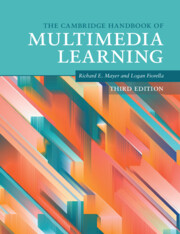Book contents
- The Cambridge Handbook of Multimedia Learning
- The Cambridge Handbook of Multimedia Learning
- Copyright page
- Contents
- Figures
- Tables
- Contributors
- Preface
- Acknowledgments
- Part I Background
- Part II Theoretical Foundations
- Part III Basic Principles of Multimedia Learning
- Part IV Principles for Reducing Extraneous Processing in Multimedia Learning
- 14 Principles for Reducing Extraneous Processing in Multimedia Learning
- 15 The Split-Attention Principle in Multimedia Learning
- 16 The Redundancy Principle in Multimedia Learning
- 17 The Signaling (or Cueing) Principle in Multimedia Learning
- 18 The Worked Example Principle in Multimedia Learning
- Part V Principles for Managing Essential Processing in Multimedia Learning
- Part VI Principles Based on Social and Affective Features of Multimedia Learning
- Part VII Principles Based on Generative Activity in Multimedia Learning
- Part VIII Multimedia Learning with Media
- Author Index
- Subject Index
- References
17 - The Signaling (or Cueing) Principle in Multimedia Learning
from Part IV - Principles for Reducing Extraneous Processing in Multimedia Learning
Published online by Cambridge University Press: 19 November 2021
- The Cambridge Handbook of Multimedia Learning
- The Cambridge Handbook of Multimedia Learning
- Copyright page
- Contents
- Figures
- Tables
- Contributors
- Preface
- Acknowledgments
- Part I Background
- Part II Theoretical Foundations
- Part III Basic Principles of Multimedia Learning
- Part IV Principles for Reducing Extraneous Processing in Multimedia Learning
- 14 Principles for Reducing Extraneous Processing in Multimedia Learning
- 15 The Split-Attention Principle in Multimedia Learning
- 16 The Redundancy Principle in Multimedia Learning
- 17 The Signaling (or Cueing) Principle in Multimedia Learning
- 18 The Worked Example Principle in Multimedia Learning
- Part V Principles for Managing Essential Processing in Multimedia Learning
- Part VI Principles Based on Social and Affective Features of Multimedia Learning
- Part VII Principles Based on Generative Activity in Multimedia Learning
- Part VIII Multimedia Learning with Media
- Author Index
- Subject Index
- References
Summary
The signaling principle, also known as cueing principle, refers to the finding that people learn more deeply from a multimedia message when cues are added that guide attention to the relevant elements of the material or highlight the organization of the essential material. In this chapter, the main findings from research on signaling or cueing in multimedia learning are reviewed, addressing the effects of incorporating cues in the text, the picture, or both. In addition, the design of cues based on successful students’ eye movements and the effects of using experts’ or students’ eye movements as cues are discussed. This chapter shows that various types of cueing can have beneficial effects on learning and discusses potential boundary conditions.
Keywords
Information
- Type
- Chapter
- Information
- The Cambridge Handbook of Multimedia Learning , pp. 221 - 230Publisher: Cambridge University PressPrint publication year: 2021
References
Accessibility standard: Unknown
Why this information is here
This section outlines the accessibility features of this content - including support for screen readers, full keyboard navigation and high-contrast display options. This may not be relevant for you.Accessibility Information
- 20
- Cited by
